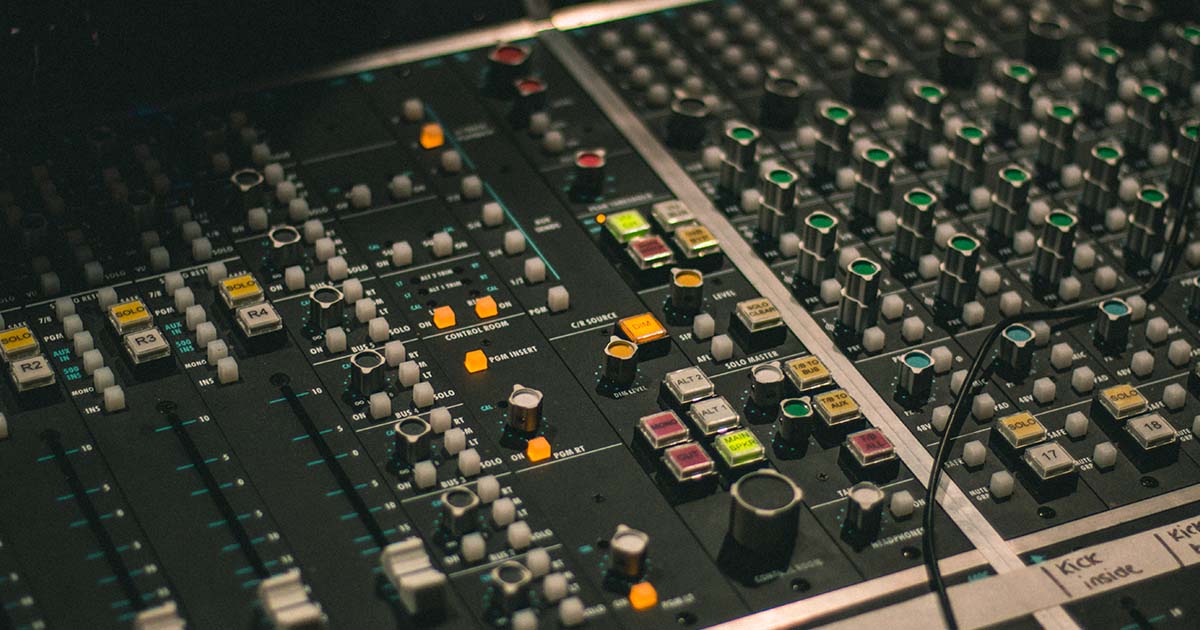Music production involves various stages, each contributing to the final polished result. One crucial step in this process is mastering. In this blog post, we will delve into the meaning of mastering and highlight its significance in music production.
What is Mastering?
Mastering is essentially the “bridge” between the creation and consumption stages, where a piece of music is polished, enhanced, and prepared for (commercial) release. It’s the art and science of ensuring that a piece of music translates well across various listening environments, from booming club speakers to the tinny earphones of a smartphone. Beyond simply adjusting volume levels, mastering involves subtle tweaks to the track’s EQ, dynamic range, stereo width, and more, to ensure that it not only sounds its best but stands shoulder-to-shoulder with other professional releases.
In the realm of electronic music, and techno in particular, mastering assumes a critical role. Given that electronic music is predominantly produced to be perceived on massive sound systems.
Historical context
The art of mastering dates back to the mid-twentieth century, before the rise of techno and electronic music. Originally, mastering was a required process in transferring music from tape to vinyl in order to ensure the highest possible quality with no technical difficulties. Engineers would carve grooves into acetate discs, altering levels and EQ to keep the needle from skipping while preserving the dynamics of the music.
As the digital age emerged, so did the number of tools and approaches available for mastery. Digital Audio Workstations (DAWs) offered mastering capabilities to bedroom producers, opening up the process. However, the essential goal remained the same: making sure a track sounded great no matter where or how it was played. So let’s have a look at what this actually involves.
The basic process of Mastering
Before embarking on the mastering journey, it’s essential to have a well-mixed track. This pre-mastering phase ensures that each element in your track, has been balanced, spaced, and detailed. A good mix offers clarity. It ensures that each sonic element has its own ‘place’ in frequency spectrum as well as in the stereo field, free from muddiness or overlapping frequencies. Furthermore, it’s crucial to ensure there is sufficient ‘headroom,’ meaning the audio doesn’t peak or clip, allowing the mastering engineer the necessary sonic freedom to enhance the track effectively. This sonic space is vital for the mastering process to unfold optimally. (I’m going to discuss this topic in a separate article because I believe that many misconceptions revolve around the the pre-master file). When this is achieved, mastering can truly shine, enhancing the track’s nuances, taming its dynamics, and preparing it for a diverse range of playback systems. The master engineer has a number of tools at his disposal for this purpose. Here is a list of some key tools/techniques:
- Equalizers (EQs): Used to adjust the balance of frequencies in a track. This can help brighten a mix, clear out muddiness, or give emphasis to certain frequency ranges, ensuring the track sounds balanced across various systems.
- Compressors: These work on the dynamics of a track. By controlling the peaks and troughs, compressors ensure a more consistent volume level, making the track sound more cohesive and polished.
- Limiters: A subtype of compressor, limiters ensure that the track does not exceed a certain volume level, preventing distortion and clipping. This is especially crucial when preparing a track for commercial release.
- Stereo Imagers: These tools widen or narrow the stereo field of a track. In electronic music, especially techno, a vast stereo image can provide an enveloping experience, drawing listeners into the track’s ambiance.
- Harmonic Exciters and Saturators: These add subtle harmonics or saturation to a track, often giving it warmth, character, or a certain ‘sheen’ that might be desired in the final output.
- Mid-Side Processing: This technique separates the mono (center) and stereo (side) information within a stereo track, allowing engineers to apply different processing to each. It’s valuable for fine-tuning the stereo image and balance.
Typically, mastering engineers can utilize these tools to address particular frequency bands and pinpoint specific audio issues.
What is the difference between Mixing and Mastering?
Mixing: At its core, mixing is about balance. It revolves around combining multiple individual tracks of a song—be it vocals, instruments, or synthesised sounds — into a cohesive whole. The focus is on ensuring each element sits well in the mix, has its own space, and contributes harmoniously to the overall sound.
Mastering: Mastering is the final polish. Once the mixing is complete, mastering takes the consolidated track (or tracks, in the case of an album or EP) and fine-tunes it for playback across different systems and platforms. The objective is to ensure consistency in dynamics, optimal loudness and frequency balance so that the music translates well in various listening environments.
In essence: mixing occurs in the project file of a tune (whether digital or on a mixing desk) with all of its tracks or channels open, whereas mastering usually only uses the consolidated audio file of all channels and effects involved.
Nuances of mastering techno
As mentioned earlier, mastering techno requires a focus on specific aspects compared to other genres. Techno, designed primarily for clubs and large sound systems, contrasts with genres like Hip-Hop, which often find their audience through streaming services and, consequently, headphones or car speakers. In my opinion, streaming and private consumption are of secondary importance for techno.
Particular points of emphasis include:
- Mono Compatibility: In the context of techno music, which often take place in venues with huge sound systems, mono compatibility is crucial. Some PA (Public Address) systems may operate in mono.
- Adequate frequency balance: Adequate frequency balance is vital in mastering techno tracks to ensure that each element occupies its rightful sonic space. Techno often involves complex layering of sounds, and mastering engineers need to delicately balance frequencies to prevent certain elements from dominating the mix.
- Low end compression: The low end in techno, especially the bass, plays a central role. As tracks are played at louder volumes in club environments, mastering for precise dynamic range becomes crucial. Applying appropriate compression to the low end ensures that the bass remains impactful without becoming overly dominant or muddy, even at high playback volumes.
- Vinyl compatibility: vinyl compatibility in mastering involves tailoring the audio characteristics to align with the physical properties of vinyl records. It’s about optimizing the sound to ensure a smooth and faithful reproduction on vinyl players, respecting the medium’s unique characteristics and challenges.
- Industry standard loudness: Industry-standard loudness refers to the perceived loudness level that is commonly accepted and expected in professional music production. In the context of mastering techno tracks, aiming for a loudness level between approximately -9 and -7 LUFS (Loudness Units Full Scale) is a common practice. This ensures that the techno track can compete with other professional tracks in terms of perceived loudness and impact.
Do It Yourself vs. Hiring a Professional
Mastering is often considered more of an art form than a purely technical process. Especially at the beginning of a producer’s career, attempting to master a track can be challenging. The nuances that experienced mastering engineers hear, such as subtle changes in dynamics, can be difficult to discern for someone with less experience.
It’s essential to understand that mastering isn’t always a necessary step for every track, particularly for emerging producers. When you’re starting, many record labels will handle the mastering process if they decide to sign your track. They have the expertise and the trained ears to ensure your music meets industry standards.
My advice for aspiring producers is to focus on honing your creative production skills and perfecting your mixes. When you can consistently create well-balanced and tight mixes, you’ll be better prepared to dive deeper into the world of mastering. At that point, you can either explore mastering yourself or consider working with a professional mastering engineer who can bring out the best in your music.
Mastering online services
While there are online mastering services available, it’s important to approach them with caution. Every track and genre is unique, and online services often apply generalized algorithms that might not capture the specific essence of your music. I believe that, at least for now, these services might fall short of the personalized touch that a skilled mastering engineer can provide.
Additional Resources
Mastering is a nuanced and multifaceted process, and while this blog post provides a foundational understanding, it only scratches the surface of this intricate art. The intricacies of mastering extend far beyond what we’ve covered here, encompassing a delicate balance of technical expertise, artistic intuition, and an acute understanding of various playback environments.
For those keen on delving deeper into mastering, I recommend exploring additional resources, such as this video series with mastering engineer Jonathan Wyner:







